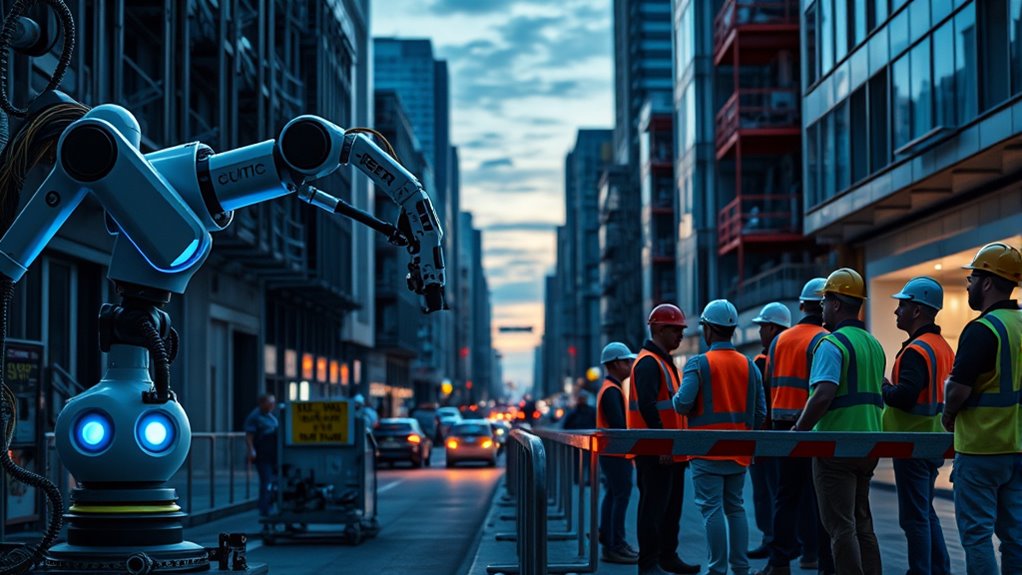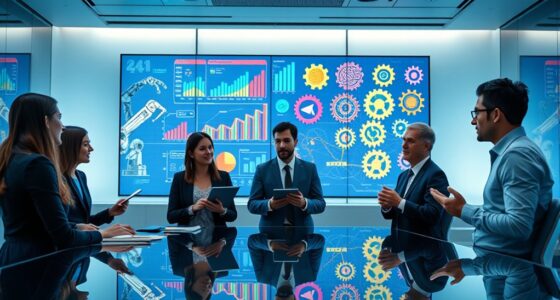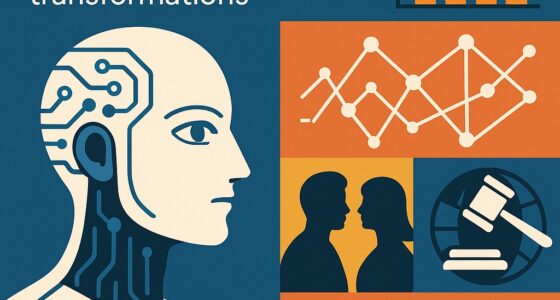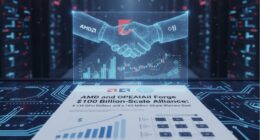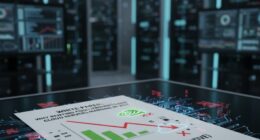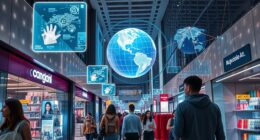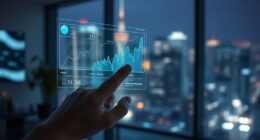Balancing AI safety and job security is essential because both impact your well-being and society’s progress. Ensuring AI systems are safe prevents risks like bias, errors, and cybersecurity threats, protecting lives and data. At the same time, job safety concerns address employment stability and economic well-being. Striking the right balance means developing standards that foster innovation without compromising safety or workers’ rights. To understand how this balance can be achieved, keep exploring the key factors involved.
Key Takeaways
- Prioritizing AI safety ensures reliable systems, reducing risks of errors that could threaten worker and public safety.
- Job safety focuses on protecting workers from physical harm and workplace hazards during AI-driven automation.
- Balancing both is critical; neglecting AI safety can lead to accidents, but ignoring job safety risks worker well-being.
- Effective regulation should address AI safety standards while maintaining protections for employees.
- The debate hinges on whether safeguarding human lives and trust outweighs concerns about employment disruptions.

As artificial intelligence becomes more integrated into our workplaces and daily lives, the debate over AI safety versus job safety intensifies. You might wonder whether embracing AI’s potential benefits outweighs the risks it poses, especially when it comes to safety concerns. On one hand, AI can revolutionize healthcare, cybersecurity, and productivity, but on the other, it introduces significant hazards that could jeopardize your safety and well-being.
Balancing AI innovation with safety is vital to protect your well-being in a rapidly evolving world
In healthcare, AI ranks as the top technology hazard for 2025, according to ECRI, mainly due to False diagnoses and biased outcomes. You need to be cautious because AI hallucinations—erroneous results generated by AI—can threaten patient care, especially across diverse populations. The risks aren’t just theoretical; recent malware like the Morris II worm, detected in April 2024, shows how AI-driven malicious software can extract sensitive financial data, exposing you to financial harm. Additionally, non-regulated AI systems used for scheduling and documentation can operate without oversight, potentially leading to errors that affect your safety. Academic panels have raised concerns about gaps in third-party AI model evaluations and whistleblowing policies, which means potential issues might go unnoticed until it’s too late.
Cybersecurity is another arena where AI’s role becomes a double-edged sword. Over half of security professionals see AI as critical to defending against rising cyber threats, and the AI cybersecurity market is projected to grow exponentially, from $15 billion in 2021 to $135 billion by 2030. While AI tools can be more cost-efficient than human counterparts, over 90% of these tools come from third-party providers, complicating trust and reliability. AI-enabled ransomware can bypass traditional defenses, encrypting your data and causing catastrophic disruptions. This means your personal and organizational information could be at risk if proper safety measures aren’t in place, raising questions about whether the pursuit of innovation is outpacing safety protocols.
You also face challenges during AI implementation at work. Employees are concerned about security, privacy, and accuracy, especially as rapid deployment often skips thorough safety audits. Unpredictable AI threats, like malware outbreaks, demand quick responses that many organizations are ill-prepared for. The pressure to implement AI swiftly can lead to overlooked safety measures, increasing the risk of accidents or data breaches affecting you directly.
Bias and marginalization are another serious concern. AI systems can perpetuate existing biases, leading to unfair treatment or misdiagnoses that disproportionately impact marginalized groups. False positives or negatives, often called hallucinations, can have severe consequences for vulnerable populations. Transparency and independent evaluations are crucial to addressing these issues, but organizations frequently fall short, leaving you exposed to biased outcomes.
Ultimately, the ongoing debate hinges on whether the advantages of AI outweigh the potential dangers. While AI offers transformative benefits, your safety—whether in healthcare, cybersecurity, or workplace environments—must remain a priority. Striking the right balance requires rigorous standards, transparent practices, and proactive safety measures to ensure that progress doesn’t come at the cost of your well-being.
Frequently Asked Questions
How Do AI Safety Concerns Impact Global Economic Stability?
You should consider how AI safety concerns impact global economic stability because breaches and vulnerabilities can cause significant financial losses, disrupt markets, and undermine trust. When AI systems aren’t secure, it risks widespread data leaks, costly penalties, and prolonged incidents that slow economic growth. Balancing innovation with robust security measures guarantees that AI’s productivity benefits are sustained without triggering instability or eroding confidence in the global economy.
What Industries Are Most at Risk From AI Automation?
Imagine a conveyor belt speeding up, threatening to toss workers off—this captures how manufacturing faces the highest AI automation risk, with over 1.7 million jobs lost globally. You’re most at risk in manufacturing and logistics, where repetitive tasks are replaced by robots and AI. Healthcare and retail also face significant shifts, but manufacturing’s reliance on automation makes it the clearest example of industries most vulnerable to AI-driven change.
Can AI Safety Measures Hinder Technological Progress?
You might worry that AI safety measures could slow down progress. When safety protocols get complex, they extend development cycles, making it harder to push updates quickly. Regulatory requirements and thorough testing demand resources and time, which could divert focus from innovation. While safety is vital, it’s essential to balance these measures so they don’t hinder technological advancements that could benefit society in the long run.
How Do Policymakers Balance AI Risks and Job Security?
Ever wonder how policymakers keep both innovation and employment safe? They’re balancing AI risks and job security by enacting laws that promote responsible development, like safety audits and transparency requirements. They also push for worker protections through whistleblower laws and retraining programs. While regulations aim to prevent job displacement, they still encourage growth. Isn’t it about creating a future where AI benefits everyone without sacrificing livelihoods?
What Role Does Public Perception Play in AI Regulation?
Public perception plays a huge role in AI regulation because it shapes policies and priorities. When you support stronger laws and trust in government oversight, policymakers feel more compelled to act. Your concerns about misinformation, privacy, and accountability influence lawmakers to implement clearer, international, and co-regulatory frameworks. The more aware and engaged you are, the more pressure there is for transparent, effective AI regulations that align with public expectations.
Conclusion
As you stand at this crossroads, imagine a future where towering AI systems guard our world like vigilant sentinels, ensuring safety. But remember, behind every machine, there’s a human heartbeat, risking silence in the wake of progress. Balancing AI safety with your job safety is like walking a tightrope over a stormy sea—daring yet delicate. It’s up to you to steer this ship wisely, so both safety and jobs can thrive in harmony.
